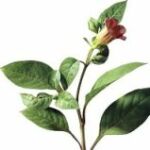| Taking belladonna with these drugs may enhance the drug's therapeutic and adverse effects: |
| Acetominophen, Chlorpheniramine, and Pseudoephedrine, (Children's Tylenol Plus Cold; Sinutab Sinus Allergy Maximum Strength) |
Acetominophen, Dextromethorphan, and Pseudoephedrine, (Alka-Seltzer Plus Flu Liqui-Gels, Sudafed Severe Cold) |
Acrivastine and Pseudoephedrine, (Semprex-D) |
Amantadine, (Endantadine, Symmetrel) |
Amitriptyline, (Elavil, Levate) |
Amitriptyline and Chlordiazepoxide, (Limbitrol) |
Amitriptyline and Perphenazine, (Etrafon, Triavil) |
Amoxapine, (Asendin) |
Azatadine, (Optimine) |
| Azatadine and Pseudoephedrine, (Rynatan Tablet, Trinalin) |
Azelastine, (Astelin, Optivar) |
Brompheniramine and Pseudoephedrine, (Children's Dimetapp Elixir Cold & Allergy, Lodrane) |
Carbinoxamine, (Histex CT, Histex PD) |
Carbinoxamine and Pseudoephedrine, (Rondec Drops, Sildec) |
Carbinoxamine, Pseudoephedrine, and Dextromethorphan, (Rondex-DM Drops, Tussafed) |
Cetirizine, (Reactine, Zyrtec) |
Chlorpheniramine and Acetominophen, (Coricidin HBP Cold and Flu) |
Chlorpheniramine and Phenylephrine, (Histatab Plus, Rynatan) |
| Chlorpheniramine, Ephedrine, Phenylephrine and Carbetapentane, (Rynatuss, Tynatuss Pediatric) |
Chlorpheniramine, Phenylephrine, and Dextromethorphan, (Alka-Seltzer Plus Cold and Cough) |
Chlorpheniramine, Phenylephrine, and Methscopolamine, (AH-Chew, Extendryl) |
Chlorpheniramine, Phenylephrine, and Phenyltoloxamine, (Comhist, Nalex-A) |
Chlorpheniramine, Phenylephrine, Codeine, and Potassium Iodide, (Pediacof) |
Chlorpheniramine, Pseudoephedrine, and Codeine, (Dihistine DH, Ryna-C) |
Chlorpheniramine, Pseudoephedrine, and Dextromethorphan, (Robitussin Pediatric Night Relief, Vicks Pediatric 44M) |
Chlorpromazine, (Thorazine, Largactil) |
Cimetidine, (Nu-Cimet, Tagamet) |
| Clemastine, (Tavist Allergy) |
Clomipramine, (Anafranil, Novo-Clopramine) |
Cyproheptadine, (Periactin) |
Deptropine, (Deptropine FNA) |
Desipramine, (Alti-Desipramine, Norpramin) |
Desloratadine, (Aerius, Clarinex) |
Dexbrompheniramine and Pseudoephedrine, (Drixomed, Drixoral Cold & Allergy) |
Dexchlopheniranine, (Polaramine) |
Dimethidine, (Fenistil) |
| Diphenhydramine, (Benadryl Allergy, Nytol) |
Diphenhydramine and Pseudoephedrine, (Benadryl Allergy/Decongestant, Benadryl Children's Allergy and Sinus) |
Doxepin, (Sinequan, Zonalon) |
Doxylamine and pyridoxine, (Diclectin) |
Epinastine, (Elestat) |
Famotidine, (Apo-Famotidine, Pepcid) |
Fexofenadine, (Allegra) |
Fexofenadine and Pseudoephedrine, (Allegra-D) |
Fluphenazine, (Modecate, Prolixin) |
| Hydrocodone and Chlorpheniramine, (Tussionex) |
Hydrocodone, Carbinoxamine, and Pseudoephedrine, (Histex HC, Tri-Vent HC) |
Hydroxyzine, (Atarax, Vistaril) |
Imipramine, (Apo-Imipramine, Tofranil) |
Ketotifen, (Novo-Ketotifen Zaditor) |
Levocabastine, (Livostin) |
Lofepramine, (Feprapax, Gamanil) |
Loratadine, (Alavert, Claritin) |
Loratadine and Pseudoephedrine, (Claritin-D 12 Hour, Claritin-D 24 Hour) |
| Mebhydrolin, (Bexidal, Incidal) |
Melitracen, (Dixeran) |
Mesoridazine, (Serentil) |
Mizolastine, (Elina, Mizollen) |
Nizatidine, (Axid, PMS-Nizatidine) |
Nortriptyline, (Aventyl HCl, Pamelor) |
Olopatadine, (Patanol) |
Oxatomide, (Cenacert, Tinset) |
Perphenazine, (Apo-Perphenazine, Trilafon) |
| Procainamide, (Procanbid, Pronestyl-SR) |
Prochlorperazine, (Compazine, Compro) |
Promethazine, (Phenergan) |
Promethazine and Codeine, (Pherergan with Codiene) |
Promethazine and Dextromethorphan, (Promatussin DM) |
Promethazine and Phenylephrine, (Promethazine and Phenylephrine) |
Promethazine, Phenylephrine, and Codeine, (Promethazine, Phenylephrine, and Codeine) |
Protriptyline, (Vivactil) |
Quinidine, (Novo-Quinidine, Quinaglute Dura-Tabs) |
| Ranitidine, (Alti-Ranitidine, Zantac) |
Thiethylperazine, (Torecan) |
Thioridazine, (Mellaril) |
Thiothixene, (Navane) |
Trifluoperazine, (Novo-Trifluzine, Stelazine) |
Trimipramine, (Apo-Trimip, Surmontil) |
Tipelennamine, (PBZ, PBZ-SR) |
Triprolidine and Pseudoephedrine, (Actifed Cold and Allergy, Silafed) |
Triprolidine, Pseudoephedrine, and Codeine, (CoActifed, Covan) |
